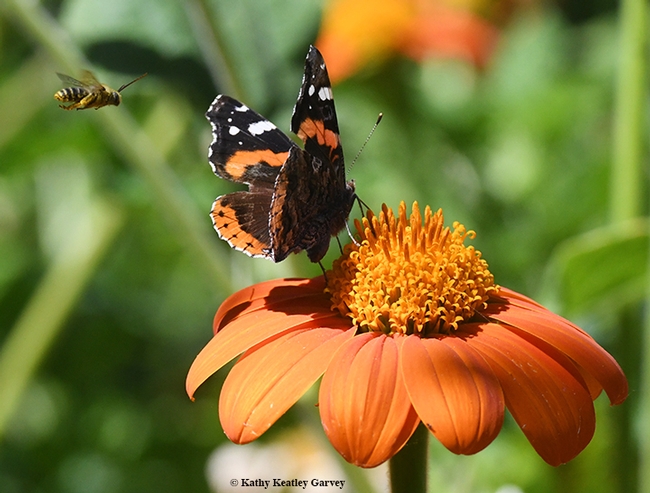- Author: Kathy Keatley Garvey
So here's this crab spider stalking a katydid nymph foraging on a Mexican sunflower, Tithonia rotundifola.
Dinner awaits!
Suddenly a native bee, Melissodes agilis, lands next to the katydid and begins to sip some nectar.
Decisions, decisions! Do I want a juice katydid nymph or a tasty long-horned bee? Do I have a choice in the matter or does it matter if I have a choice?
A moment in time. Time in a moment. The bee, unaware of danger, continues to forage. Then, abruptly, the bee takes flight.
One menu choice remains.
It was a good day for the crab spider.
It was not a good day for the katydid.
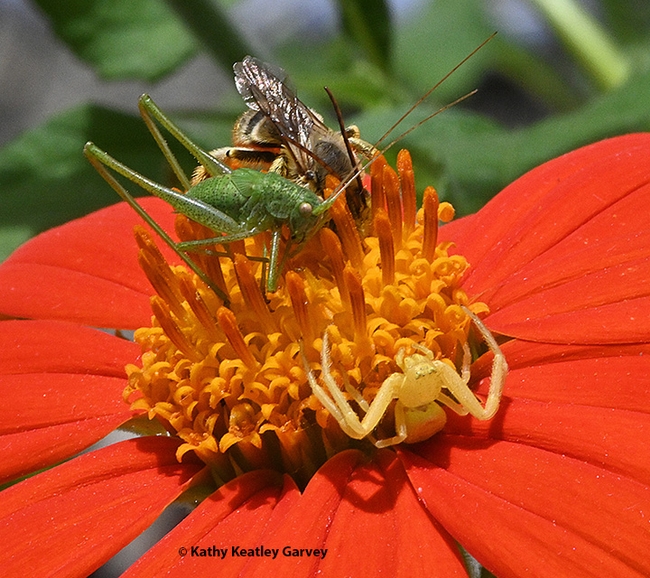
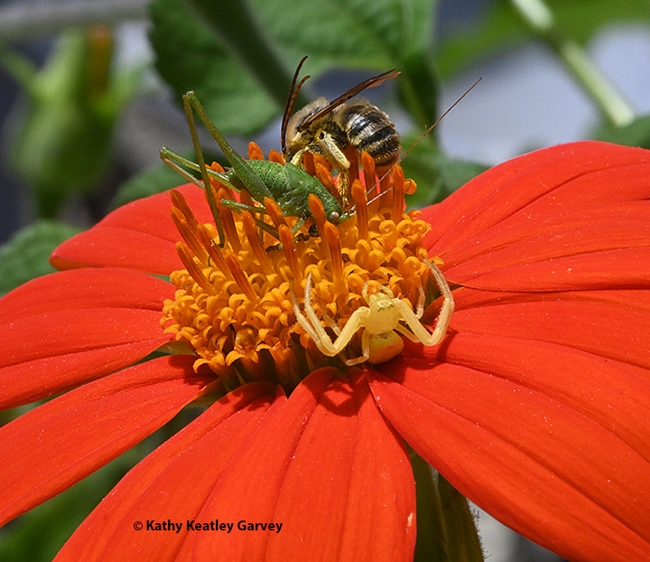
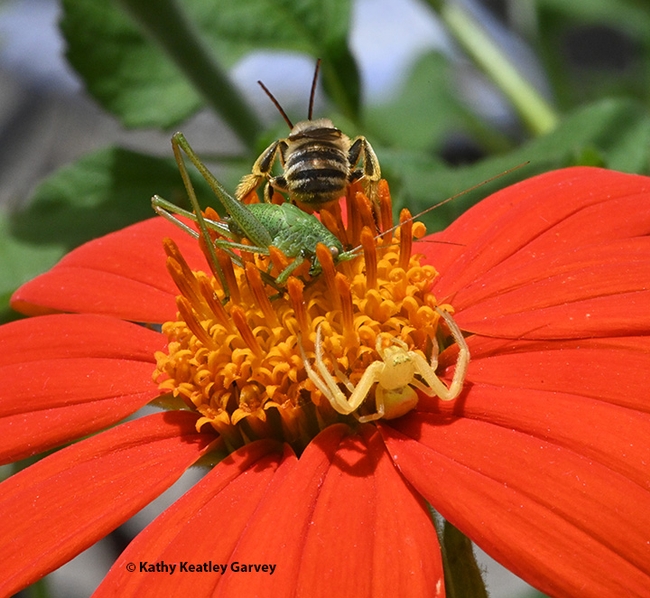
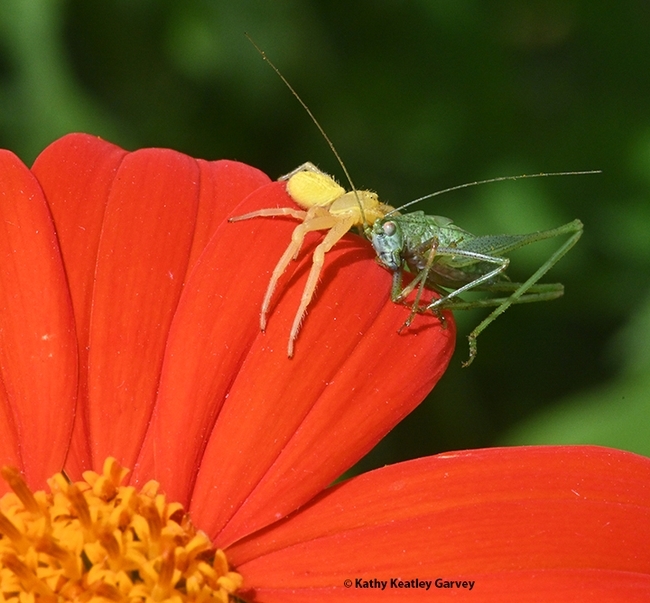
- Author: Kathy Keatley Garvey
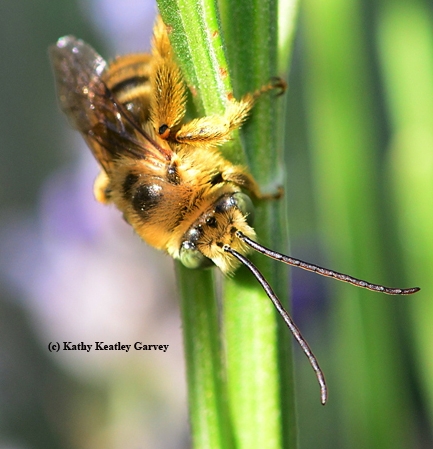
A female Melissodes agilis, the so-called "agile longhorned bee," is foraging on a Mexican sunflower, Tithonia rotundifola.
Longhorned? So named because they have unusually long antennae. Think of this species as the insect version of Texas longhorns!
Melissodes are ground-nesting solitary bees. While the males congregate on a flower to sleep overnight, each female is returns to her ground nest.
This female (below) rose early on July 3 to sip a little nectar while the males were fast asleep.
We find this species every year on our Mexican sunflowers, Tithonia rotundifola, in our family's Vacaville pollinator garden. It's native to North America and Central America.
They're a delight to see. The males are quite territorial as they target assorted critters on "their" flowers. As the late pollinator specialist Robbin Thorp, UC Davis distinguished emeritus professor of entomology, used to say: "They're saving the flowers for the females of their species, so they can mate with them."
But if you're a "gal bee" and awaken early, you have the flowers all to yourself.
Thorp used to tell us there are some 20,000 undomesticated bee species are there in the world. Some 4000 species llve in the United States. And some 1600 species, including Melissodes agilis, live in California.
Internationally recognized for his expertise, Thorp co-authored two books in 2014: the UC California book, California Bees and Blooms: A Guide for Gardeners and Naturalists (Heyday) and Bumble Bees of North America: An Identification Guide (Princeton University Press).
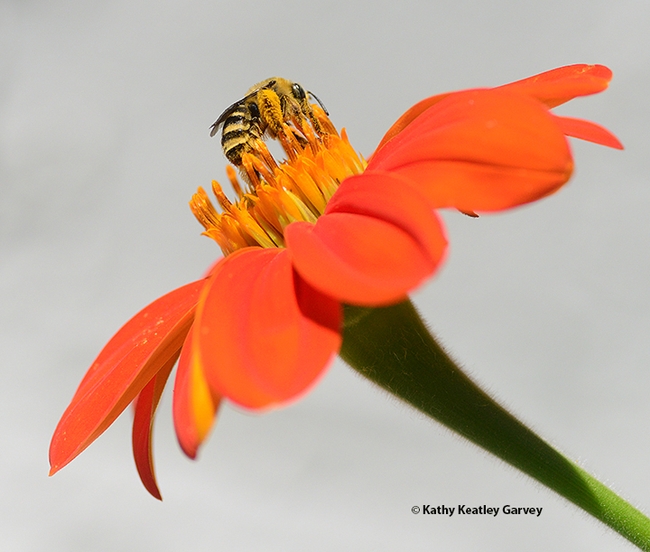
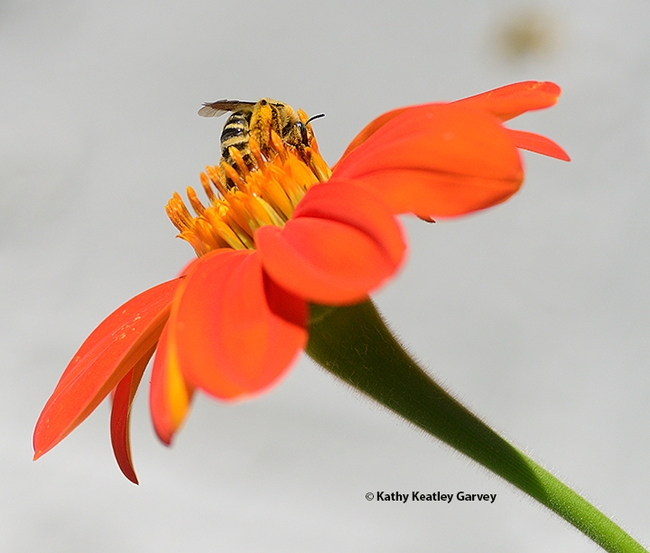
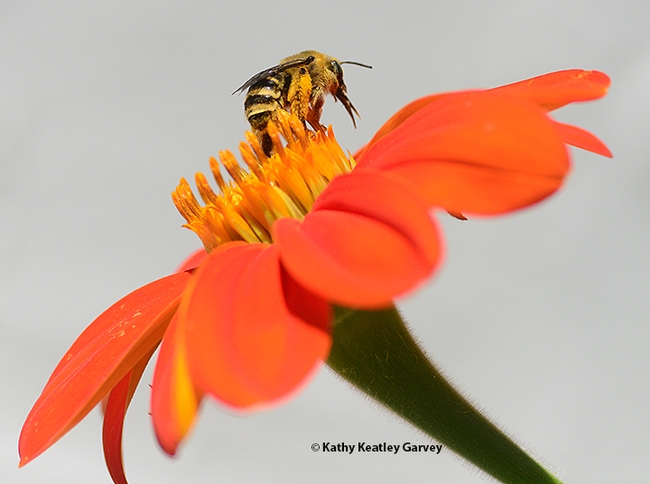
- Author: Kathy Keatley Garvey
So here's this Gulf Fritillary, Agraulis vanillae, nectaring on a Mexican sunflower, Tithonia rotundifola.
It's National Pollinator Week. All's right with the world. The butterfly had visited a passionflower vine, Passiflora, its host plant.
Now for a little fuel. The nectar is enticing. The Gulf Frit flutters from flower to flower.
And then...it's targeted.
Get off my flower, that's mine! A very territorial male long-horned bee, Melissodes agilis, buzzes past, trying to dislodge the butterfly. Then another male appears. And another.
What's going on? Like frenzied kamikaze pilots, the males patrol the flowers, dive-bombing and dislodging any temporary tenants, in hopes of saving the nectar for the females of their species. And to mate with them.
It works.
After four attacks, the Gulf Frit decides the nectar is not worth it.
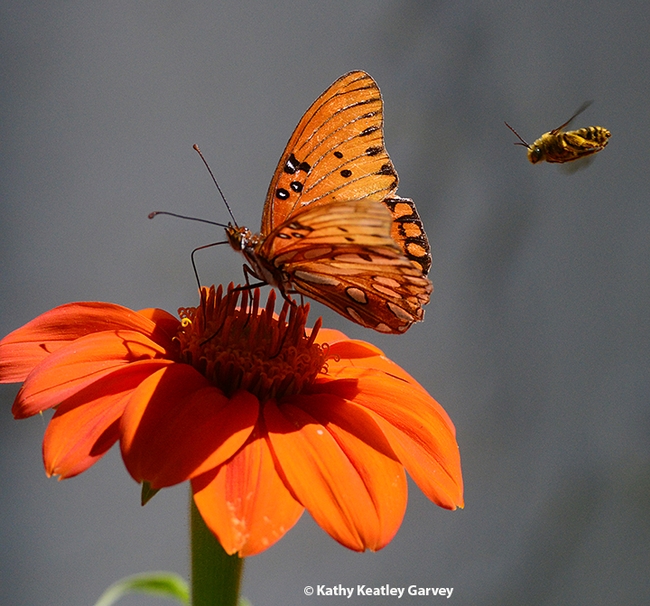
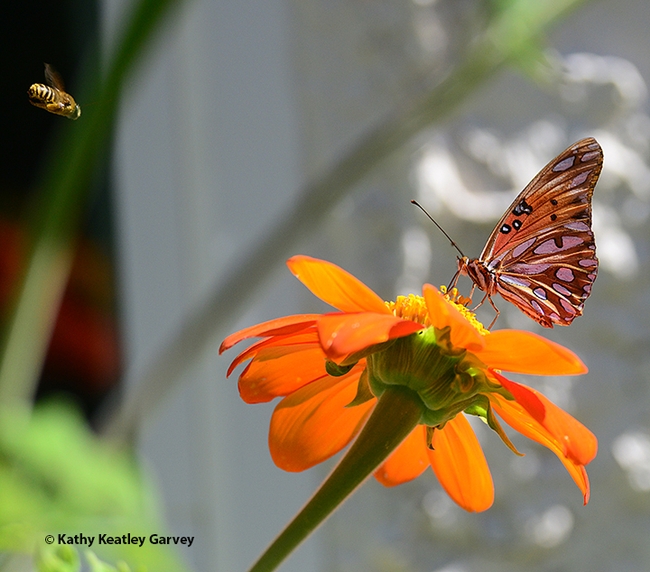
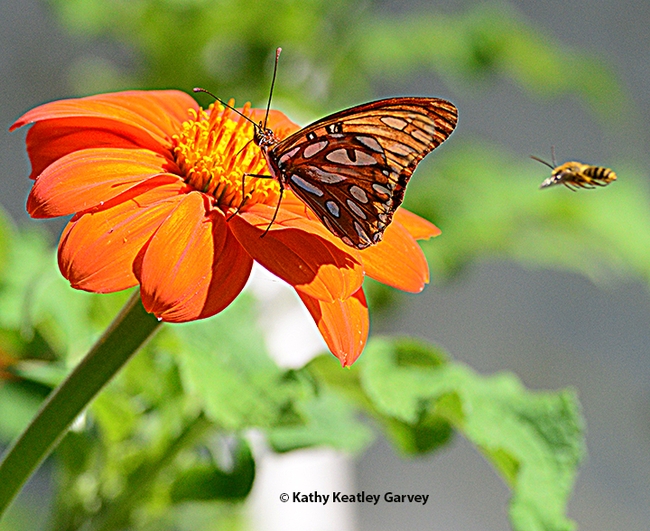
- Author: Kathy Keatley Garvey
Hey, the sun's up! It's time to rise and shine! Maybe I'll shine before I rise...or maybe I'll...
Anyway, I just woke up, and I'm starting to stir. I'm ready to conquer the day. I shall
- Sip nectar
- Seek girlfriend
- Guard the flower patch by dive-bombing and chasing off all critters.
- Repeat.
The scenario: a male longhorned bee, Melissodes agilis, has just spent the night sleeping--and quite cozily at that--on a Mexican sunflower, Tithonia rotundifola.
He is Boy Bee With the Green Mesmerizing Eyes.
Boy Bee With the Green Mesmerizing Eyes does not know--nor would he care if he could--that today is the beginning of National Pollinator Week, an international annual event celebrating pollinator health.
According to the Pollinator Partnership, "pollination is a vital stage in the life cycle of all flowering plants. When pollen is moved within a flower or carried from one flower to another of the same species it leads to fertilization. This transfer of pollen is necessary for healthy and productive native and agricultural ecosystems." It's crucial to our ecosystem.
As the Pollinator Partnership says on its website:
- "About 75 percent of all flowering plant species need the help of animals to move their heavy pollen grains from plant to plant for fertilization."
- "About 1,000 of all pollinators are vertebrates such as birds, bats, and small mammals."
- "Most pollinators (about 200,000 species) are beneficial insects such as flies, beetles, wasps, ants, butterflies, moths, and bees."
But back to Boy Bee With the Mesmerizing Green Eyes.
Noted bee expert, the late Robbin Thorp, a UC Davis distinguished emeritus professor of entomology and co-author of California Bees and Blooms: A Guide for Gardeners and Naturalists (Heyday), used to talk about these little guys bullying all the floral tenants--from honey bees to syrphid flies to butterflies to lady beetles--and more.
Boy, do they move fast. A good time to photograph them is when they're sleeping or just waking up. Otherwise, try to capture images of them at a shutter speed of about 1/5000 of a second.
Happy Beginning of National Pollinator Week!
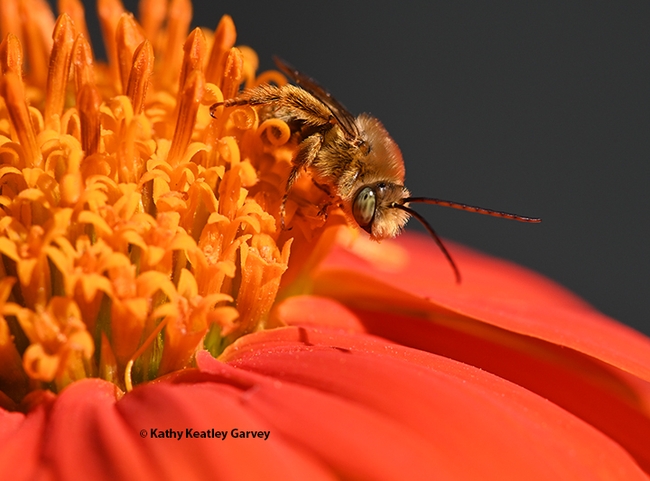
- Author: Kathy Keatley Garvey
It was not a good way to welcome an admiral.
The Red Admiral butterfly, that is.
The Vanessa atalanta fluttered into our pollinator garden on Sunday, July 16 in Vacaville, Calif., and touched down on a Mexican sunflower (Tithonia).
The warmth of the sun, the rich nectar, a soft breeze, and all was well.
For a little while.
Several territorial male long-horned bees spied the stranger and pulled out the welcome mat. In a frenzy, they began dive-bombing the colorful black and red butterfly, trying to chase it away. "Those flowers are for our girls!" they seemed to say. "Leave! Now!"
Everywhere the butterfly went, a squadron of bombers followed. The sailboat-like wings proved a clear target.
One bullet-of-a-bee, probably a Melissodes agilis, slammed into the butterfly's wings, and that was enough.
"This pollinator garden's not big enough for both of us!"

